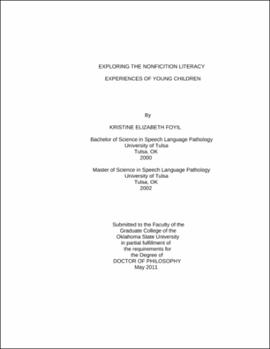| dc.contributor.advisor | Sanders, Jennifer | |
| dc.contributor.author | Foyil, Kristine Elizabeth | |
| dc.date.accessioned | 2013-11-26T08:34:28Z | |
| dc.date.available | 2013-11-26T08:34:28Z | |
| dc.date.issued | 2011-05 | |
| dc.identifier.uri | https://hdl.handle.net/11244/7402 | |
| dc.description.abstract | Scope and Method of Study: | |
| dc.description.abstract | Research has demonstrated that before fourth grade, young children have limited experiences with nonfiction texts. The majority of studies about nonfiction literacy development focus on school age children and there is limited information about younger children and their experiences with nonfiction. This multiple case study examined how young children between the ages for two and five years of old experienced and developed nonfiction literacy. The literacy events and routines of 13 children, their families and their classroom environments were analyzed using the constant comparative and thematic analysis methods to understand how nonfiction literacy development is shaped by literacy sponsors. This study answered the following research questions: 1) who are the sponsors of nonfiction literacy development for young children ages two to five years old? 2) How do sponsors shape the nonfiction literacy routines and experiences for young children ages two to five years old? 3) What kinds of nonfiction genre knowledge do young children construct during their nonfiction literacy routines? | |
| dc.description.abstract | Findings and Conclusions: | |
| dc.description.abstract | Findings indicate that nonfiction literacy development was sponsored by people, the places they enact and their personal practices. The people who sponsored the young children's nonfiction literacy experiences included parents, teachers, siblings, grandparents and the child. The places included school, the community, and the library. Personal practices related to religion, reading and writing shaped the young children's nonfiction literacy experiences. The informational speech genre mirrored the expository text structures of descriptive, procedural/sequential, cause and effect and compare and contrast texts. Alternative texts like dramatic play, games and puzzles, and art provided a space for informational speech. Implications of these finding are discussed. | |
| dc.format | application/pdf | |
| dc.language | en_US | |
| dc.rights | Copyright is held by the author who has granted the Oklahoma State University Library the non-exclusive right to share this material in its institutional repository. Contact Digital Library Services at lib-dls@okstate.edu or 405-744-9161 for the permission policy on the use, reproduction or distribution of this material. | |
| dc.title | Exploring the nonfiction literacy experiences of young children | |
| dc.contributor.committeeMember | Parsons, Sue | |
| dc.contributor.committeeMember | Worley, Virginia | |
| dc.contributor.committeeMember | Zhao, Guoping | |
| osu.filename | Foyil_okstate_0664D_11374.pdf | |
| osu.accesstype | Open Access | |
| dc.type.genre | Dissertation | |
| dc.type.material | Text | |
| dc.subject.keywords | early literacy | |
| dc.subject.keywords | informational speech genre | |
| dc.subject.keywords | nonfiction | |
| dc.subject.keywords | sponsorship | |
| thesis.degree.discipline | Professional Education | |
| thesis.degree.grantor | Oklahoma State University | |
